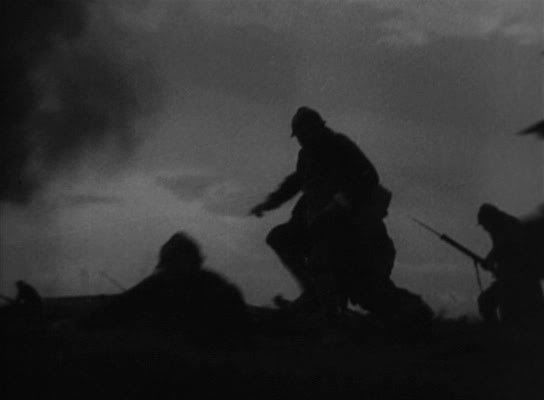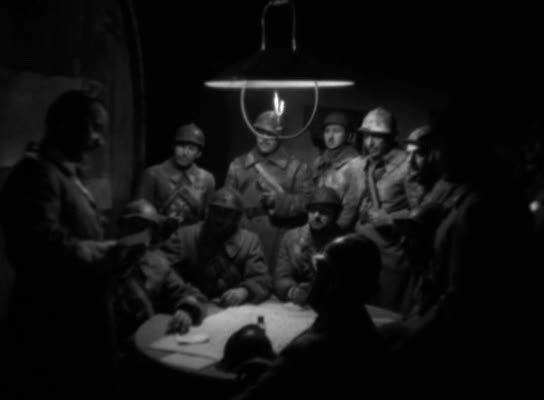
[This is a contribution to the Early Hawks Blog-a-thon hosted right here at Only The Cinema. It will run from January 12 to January 23, 2009.]
The Road To Glory is the culmination of Howard Hawks' early cycle of World War I military dramas, borrowing elements, for better or worse, from both The Dawn Patrol and Today We Live. The resulting film feels like something of a retread for those familiar with Hawks' early oeuvre, but taken on its own merits, it's a fine wartime action flick, hampered only by its abrupt turn into overwrought melodrama in its final act. The film concerns a particularly resilient company of French soldiers during the first World War, led by the brave but tormented Captain Paul La Roche (Warner Baxter), who is driven to drink and pills by his unit's inordinately high casualty rate and dangerous assignments. His only comfort is the companionship of a young local woman, Monique (June Lang), who doesn't love him but has a certain sympathy and warmth for the brave older man — not to mention gratitude for the way he has saved and taken care of her family. This dynamic is familiar, not from one of Hawks' war films, but from Tiger Shark, since it's virtually a repeat of the older man/younger woman relationship between Edward G. Robinson's crippled fisherman and the lovely Zita Johann. Naturally, as in the earlier film, a younger, more handsome man soon enough enters the picture to disrupt this comfortable but dispassionate romance. In this film, the role is taken by the newly transferred Lieutenant Michel Denet (Fredric March), who persistently pursues the beautiful Monique without knowing her importance to his superior officer.
This romantic triangle could quickly become tiresome — and its outcome is as predictable as in Tiger Shark or any of the countless other films of the era that exploited similar setups — but Hawks conspicuously downplays the romance. The scenes between Michel and Monique are subtle and moody, touching for the way the two young lovers find in each other a brief respite from the horrors of war all around them. This symbolic quality of their love is established right from the moment they meet, when Monique takes shelter in a basement from a German air raid, only to find Michel quietly playing an abandoned piano amid the rubble. Later, with their love developing, they return to this basement for a moving scene that Hawks ends with a discreet fade to black that says it all. Hawks keeps these scenes to a minimum, but he uses Lang strikingly as a figure of hope and beauty for both of these men, who desperately cling to her.
Monique, uncharacteristically for a Hawks character, has deep religious feelings — she even delivers a cloyingly earnest prayer for the men's safety at one point — but Hawks is much more interested in the way this woman has become a religion for the men who love her, a reason to live through the otherwise suffocating horrors they experience every day. Lang's natural beauty helps in this regard, but Hawks also lovingly photographs her, imparting a nearly spiritual quality into her closeups. The cinematography throughout the film is dark and atmospheric, tending towards heavy grays and blacks with very little traces of light or brightness (outside of the occasional explosion), but the scenes with Monique are as expressionist and stylized as anything in Hawks' oeuvre outside of Scarface. Her face is sculpted from the shadows, her bright white skin glowing in the dark, her porcelain features chiseled out of the blackness draped around her. In this way, Hawks is able to inject a subtle poetry into scenes that might otherwise have been token sops to the audience's desire for romance; Hawks delivers the romance, delivers the pretty girl, but he connects her appearances intimately to the film's wartime desolation.

And indeed, in many other ways this is a startlingly bleak film, perhaps even more so than Hawks' earlier The Dawn Patrol, with which it shares many similarities. Like the earlier film, The Road To Glory focuses on the repetitive, cyclical nature of military life, emphasizing the cycles of combat and downtime, the routine replacement of the dead with new recruits, the same speeches and ceremonies recurring with predictable regularity. As usual, Hawks finds room for generous helpings of humor, particularly in the character of the blustery drunken sergeant (Gregory Ratoff) who has memorized only two songs that he whistles compulsively, or in La Roche's expansive father (Lionel Barrymore), who lied about his age in order to be able to enlist. Barrymore and Ratoff get a great, hilarious scene together in which, without saying a word explicitly, they conspire to "lose" the orders that would send the eager-to-serve old Barrymore away from the front. Hawks is always conscious of the need to relieve the gloom — he even stages some dashed-off physical gags in the midst of an urgent air raid — but the film as a whole is a harrowing depiction of combat.
Most overpowering of all, in this regard, is the lengthy sequence with the company on the front lines, doing a rotation in the trenches under heavy artillery fire. When they arrive, they find that the troops they're relieving have left behind one of their men, who is trapped in the barbed wire outside the trenches, screaming and crying nonstop. The Germans have left him alive to lure men out, and those who try to reach the wounded man inevitably get machine-gunned to death. It is a blunt, grim introduction to trench warfare, and Hawks pulls no punches in dealing with the abject horror of the situation. Equally effective is the way the trench sequence becomes an exercise in clock-watching suspense once the troops hear telltale noises beneath their feet, signaling that the Germans are digging below the ground, planning to plant a mine to blow up the outpost. Unable to do anything about it, the soldiers must simply sit tight, listening to the continual tick of the shovels below the ground, waiting for their replacements to arrive. It's a nail-biting segment, made even more unnerving by the knowledge that the soldiers are essentially just waiting to pass the fate of near-certain death on to the platoons who are relieving them. They know that somebody has to die; they just don't want it to be them. This setup seems like questionable military logic — why wouldn't they just pass the news on and get ready for either an evacuation or an attack on the digging Germans? — but it's a typically Hawksian image of fatalist, stoic masculine bravery, not only facing death but implicitly accepting it, even welcoming it.

Hawks ends this sequence with a potent but simple image: the soldiers finally walking away from their post at the end of their tour of duty, only to hear the expected explosion behind them, turning to see a plume of black smoke rising into the air. "How many men?" La Roche asks, looking for a number to attach to this abstracted symbol of mortality, this rising smoke that stands like a tombstone over the impromptu graves of many men. Hawks' visual symbolism throughout this film is very pronounced, particularly for a director who so often favored more direct visual expression.
A central sequence dealing with religion, itself an unusual subject for the worldly Hawks, finds the director playfully toying with religious icons in several different ways. He first cuts directly from a battle scene to a mass in session at a church, a puzzling change of scenery until the camera pans across the congregation and the preacher, passing over a makeshift wooden divider into the hospital ward that's been set up in the other half of the church, with the injured lying in beds as nurses scurry among them. It's a striking image, uniting the treatment of the wounded with the spiritual exaltation happening just on the other side of a flimsy wooden fence. Hawks then cuts directly from this scene back to the battlefield, specifically to an image of a grave marker, a cross, turned on its side. He holds the static image for a moment, as though suggesting that religion itself has collapsed, lost its meaning in the middle of the wartime violence, and then a soldier's helmeted head begins to poke up from the bottom of the frame, slowly rising into view. It's a playful, irreverent image, and coming on the heels of Monique's earnest prayer that her two men should be kept safe (a prayer not entirely answered in the end), it suggests nothing so much as Hawks consciously undermining the religious sentiment of the preceding scene. Certainly, none of the soldiers ever pray or mention religion; Hawks heroes always know that death will come get them eventually anyway.
The film starts to unravel a bit in its final ten minutes, diverting into melodramatic distractions that directly recycle the worst elements of Today We Live: sudden blindness (in this case happening offscreen), the quest for redemption, a sacrificial mission, and of course the need to get one of these guys out of the way to resolve the romantic triangle. It's particularly out of place because Hawks had so assiduously avoided melodrama and overstatement throughout the rest of the film, which established its wartime atmosphere with such economy and blunt effectiveness. This soapy, contrived denouement is obviously a concession to give the film some sense of dramatic closure, however unsatisfying, because otherwise Hawks seemed to be driving at an anticlimactic non-ending that would emphasize the endless circularity of death and living. The final scene, basically a restaging of the final scene of The Dawn Patrol, gets at this theme anyway, ending the film on the note of ambivalence it clearly demanded: the war will continue, men will die in great numbers, many more will take their places, and any happy endings, for the two young lovers or for anyone else, are at best temporary respites from the certain approach of death.
Beyond the typical Hawks 'masculinity square'(two competing men + a woman + a weak old man), there's another side to this film.
ReplyDeleteFox had acquired the negatives of Léon Bernard's The War Crosses (Les Croix de bois), a 1932 adaptation of the French novel of the same name by Roland Dorgelès. Several scenes of The Road to Glory include re-edited images of Bernard's film, for instance the church scene, and many combat wide shots. The tunnel digging episode is a re-take of the original movie.
Watching the two films in sequence is quite interesting, especially as Hawks and Faulkner's complete betrayal of the original material make in my opinion for a much better work of art than Bernard and Dorgelès' accuracy. For sure, The War Crosses is a very fine (anti-)war movie, of historical significance. But The Road to Glory isn't a war movie, it's definitely something else... a tale of salvation - more than redemption - through the acceptance of destiny.
Catholicism is pervasive in Dorgelès' novel and Bernard's film. The wooden crosses, fighting in graves... But in the French version the prayer to 'Our Lady of the Doughboys', in the church, is actually said by the main male character. I find it significant that it is said by Monique in Hawks' film, and that as you noted none of the men are involved in the religious symbolics.
However I wouldn't say it 'undermines' the religious sentiment: rather, it affects religion to the woman. Which, considering the director's own mother notorious faith, is an interesting biographical note...